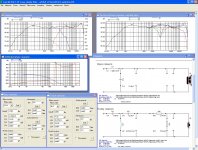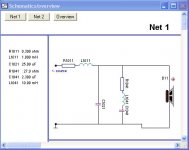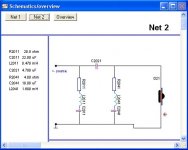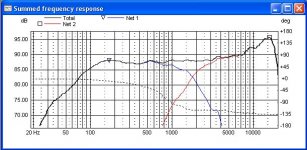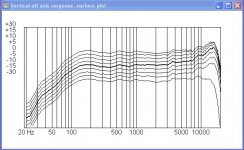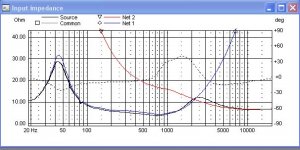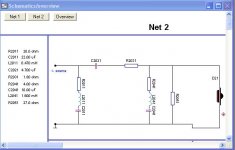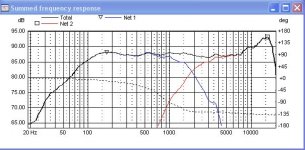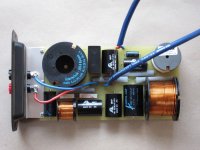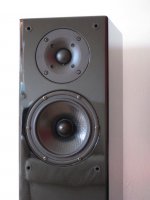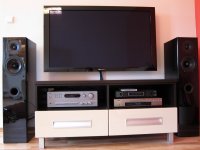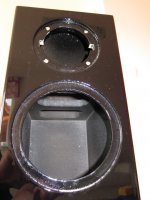Hi everyone,
I am planning to build a 2-way floor standing speaker using the following drivers
Tweeter: Ciare PT383
Mid/bass: Seas U18RNX/P
Box size 34L, bass reflex, port length 140mm diameter 58mm
I tried simulating a crossover in LspCAD 5.25 and have found a possible solution, see picture. But I am not sure if it is ok.
It was really difficult finding a good linear fit, the only one that looked good was a 2nd order 1300Hz LP and a 3rd order 2600Hz HP network.
I have only adjusted the values of the components a little so that they fit standard components which can be purchased.
Thank you in advance for any opinions/suggestions
Paul H
You will also find the frd and zma SPL and imedance data files for these drivers attached in the zip file.
I am planning to build a 2-way floor standing speaker using the following drivers
Tweeter: Ciare PT383
Mid/bass: Seas U18RNX/P
Box size 34L, bass reflex, port length 140mm diameter 58mm
I tried simulating a crossover in LspCAD 5.25 and have found a possible solution, see picture. But I am not sure if it is ok.
It was really difficult finding a good linear fit, the only one that looked good was a 2nd order 1300Hz LP and a 3rd order 2600Hz HP network.
I have only adjusted the values of the components a little so that they fit standard components which can be purchased.
Thank you in advance for any opinions/suggestions
Paul H
You will also find the frd and zma SPL and imedance data files for these drivers attached in the zip file.
Attachments
first of all change the ciare tweeter, to my taste is horrendus🙁
choice seas tweeter for example 😉
bye
choice seas tweeter for example 😉
bye
Last edited:
Hello Ermes
I already have two of these Ciare tweeters, so that is why I am thinking of using them.
Have you listened to speakers using them?
/Paul H
I already have two of these Ciare tweeters, so that is why I am thinking of using them.
Have you listened to speakers using them?
/Paul H
ok, i understand.
yes i used most of the speakers in the market, including ciare (also the tweeter model you have).
i never like them.
why you don't try to sell them, before starting with a new project ?
then you can buy tweeter (i suggest seas for perfomance/price) that interfaces well with your Seas U18RNX/P
let me know
yes i used most of the speakers in the market, including ciare (also the tweeter model you have).
i never like them.
why you don't try to sell them, before starting with a new project ?
then you can buy tweeter (i suggest seas for perfomance/price) that interfaces well with your Seas U18RNX/P
let me know
Looks like a perfect build tweeter. So ermes may be something else was wrong when it didn't sound right.
Source troelsgravensen site.








thd

Source troelsgravensen site.








thd

Ciare MT320 is even nicer very nice smooth pole piece drill through.
Ciare looks really like highest level stuff see that step response looks like a ribbon tweeter.




thd


Ciare looks really like highest level stuff see that step response looks like a ribbon tweeter.




thd


not always excellent projected productcs sounds good !
keep this in mind.
those measurements are more optimistics : does anyone measured the same tweeters ?
to me ciare tweeters sounds very bad.
So you are free to take your decision.
keep this in mind.
those measurements are more optimistics : does anyone measured the same tweeters ?
to me ciare tweeters sounds very bad.
So you are free to take your decision.
Thanks for your opinion,
I think that I will try the Ciare PT383 after all but I will create an insert in the box for the tweeter so that I can easily change it. The inserts will have different diameters for different tweeters.
With the Ciare PT383 you can use a low cross over frequency, I like that.
I have used SEAS tweeters a couple of times before, they sound ok but are definately not perfekt. My different Dynaudio tweeters always sounded better, but those are not available for DIY anymore.
I may also try these tweeters:
Seas 27TDFNC/GW
and
SICA LP90.28/N92 TW (I have a pair of these also)
/Paul H
I think that I will try the Ciare PT383 after all but I will create an insert in the box for the tweeter so that I can easily change it. The inserts will have different diameters for different tweeters.
With the Ciare PT383 you can use a low cross over frequency, I like that.
I have used SEAS tweeters a couple of times before, they sound ok but are definately not perfekt. My different Dynaudio tweeters always sounded better, but those are not available for DIY anymore.
I may also try these tweeters:
Seas 27TDFNC/GW
and
SICA LP90.28/N92 TW (I have a pair of these also)
/Paul H
not always excellent projected productcs sounds good !
keep this in mind.
those measurements are more optimistics : does anyone measured the same tweeters ?
to me ciare tweeters sounds very bad.
So you are free to take your decision.
I want to believe you but how can a product that reproduces with out harmonic distortion very good step repose and resonable flatness sound bad.
We have :
Lineair distorsion.
Harmonic distosion.
Step response.
Water fall.
Off axes.
power compression
If these things are good it can only be a good driver.
Or come up with the factor that explains the poor sound. Other wise it become a "yes no" discussion.
i leave in your opinion.
however think about the driver is not only a jam of perfect parameters...
i repeat "those measurements are more optimistics : does anyone measured the same tweeters ?"
about low crossover point : 38mm with 1khz...not so good....how you can go down ???
however think about the driver is not only a jam of perfect parameters...
i repeat "those measurements are more optimistics : does anyone measured the same tweeters ?"
about low crossover point : 38mm with 1khz...not so good....how you can go down ???
The crossover frequency of my design proposal is around 2kHz, see picture from LPSCad in first post. The values have been chosen so that there are minimum deviations off axis especially +15 and +30 degrees. Any other solution gives me horrendous +15 deg off axis response.
I also attached the drawing of the box in this post for those who are interested.
I also attached the drawing of the box in this post for those who are interested.
Attachments
please be patient i'll simulate for you using data measured by me with clio.
i have no much time now.
if i'll forget....please send me a private message to remember me.
bye
i have no much time now.
if i'll forget....please send me a private message to remember me.
bye
Here is a better crossover design, I used a crossover design from the German magazine Hobby HIFI May 2010 as a guideline/example.
This crossover is much more linear and has a very good off axis behavior. The only thing is that the tweeter polarity has to be inverted, personally this is no problem for me.
P.
This crossover is much more linear and has a very good off axis behavior. The only thing is that the tweeter polarity has to be inverted, personally this is no problem for me.
P.
Attachments
The tweeter increases spl here the most designers even make speakers that decrease spl above 4kHz. (Not my cup of tea.) I like the peak the ciare makes. Only not to much.Here is a better crossover design, I used a crossover design from the German magazine Hobby HIFI May 2010 as a guideline/example.
This crossover is much more linear and has a very good off axis behavior. The only thing is that the tweeter polarity has to be inverted, personally this is no problem for me.
P.
I think it can use -2dB. Use a series resistor 1,8Ohm and parallel to tweeter 27Ohm. Use metal oxide resistors no wire wound resistors.
Last edited:
Thanks for the help Helmuth, here is an updated HP net + summed frequency response.
I will only use high quality filter parts. There will probably be needed some filter adjustments after I measure the finished speakers, maybe some further attenuation of the tweeter.
I will only use high quality filter parts. There will probably be needed some filter adjustments after I measure the finished speakers, maybe some further attenuation of the tweeter.
Attachments
I think a bit a raise of SPL at 15khz isn't bad. I have the experience that at the listening position the response becomes precise flat. Although at 1 mtr precise in front one can measure a increase.Thanks for the help Helmuth, here is an updated HP net + summed frequency response.
I will only use high quality filter parts. There will probably be needed some filter adjustments after I measure the finished speakers, maybe some further attenuation of the tweeter.
I think it is good to have some standard measurement method at 1mtr. But it covers not al the behavior of a acoustic system like the loudspeaker it self on increasing distance, and the stereo system of two speakers that creates a comb filter and there for phase problems that at high frequencies decrease spl.
German wikipedia about combfilter effect.(kammfilter)
http://de.wikipedia.org/wiki/Kammfilter#Kammfilter_in_der_Tontechnik
I did stereo measurements with white noise it shout give a dancing flat line 20-20000Hz, then it is nice to see what the combfilter effect does.
Last edited:
Good God - I'd heard that Germans like their tweeters hot, but that is painful looking - poor cats/bats/dogs will cover their little ears from the extra tweeter sizzle at the top...Here is a better crossover design, I used a crossover design from the German magazine Hobby HIFI May 2010 as a guideline/example...
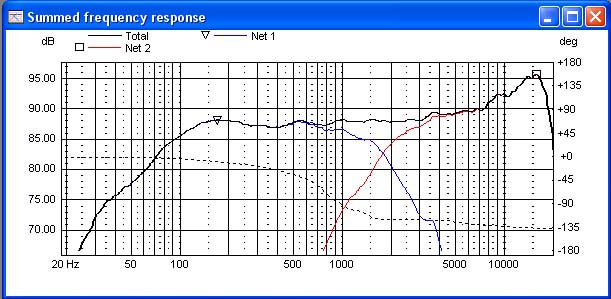
On the other hand, the off-axis is pretty impressive...
Did you notice that it was VERTICAL off-axis?
This is a too hot tweeter above 10kHz. Straight on-axis usually means a slowly descending power response which is generally considered best. Ciare is a special one, not very popular.
This is a too hot tweeter above 10kHz. Straight on-axis usually means a slowly descending power response which is generally considered best. Ciare is a special one, not very popular.
Finished project
Hello everyone,
here are some pictures (now 2 years old) of the finished project.
Verdict after 2 years, tweeters definitely not too sweet, just perfect, bass is very good in my home, probably my solid brick walls help a lot.
Overall I am very satisfied with this project.
/P
Hello everyone,
here are some pictures (now 2 years old) of the finished project.
Verdict after 2 years, tweeters definitely not too sweet, just perfect, bass is very good in my home, probably my solid brick walls help a lot.
Overall I am very satisfied with this project.
/P
Attachments
Hello everyone,
here are some pictures (now 2 years old) of the finished project.
Verdict after 2 years, tweeters definitely not too sweet, just perfect, bass is very good in my home, probably my solid brick walls help a lot.
Overall I am very satisfied with this project.
/P
That looks promising. I like big dome tweeters alot, specifically the T35C002 and TW034XO. They both sound surprisingly similar. That Ciare tweeter can be hard to work with. Its very sensitive to baffle placement and I would recommend an LCR trap to equalize the resonance impedance peak.
You Europeans are lucky to have concrete construction. It sounds much better than the typical flimsy studded wood and drywall houses we have here in the US. At least I have a single level house with vaulted ceilings and a concrete slab sub floor.
- Home
- Loudspeakers
- Multi-Way
- Ciare PT383, Seas U18RNX/P crossover opinions needed
